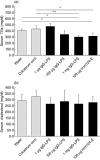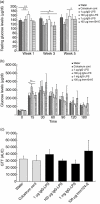Oral administration of immunoglobulin G-enhanced colostrum alleviates insulin resistance and liver injury and is associated with alterations in natural killer T cells
- PMID: 22236001
- PMCID: PMC3278691
- DOI: 10.1111/j.1365-2249.2011.04511.x
Oral administration of immunoglobulin G-enhanced colostrum alleviates insulin resistance and liver injury and is associated with alterations in natural killer T cells
Abstract
Insulin resistance and metabolic syndrome are chronic inflammatory conditions that lead to hepatic injury and non-alcoholic steatohepatitis (NASH). Bovine colostrum has therapeutic effects in a variety of chronic infections. However its effectiveness in NASH was never studied. Natural killer T (NKT) cells have been shown to be associated with some of the pathological and metabolic abnormalities accompanying NASH in leptin-deficient (ob/ob) mice. In the present study, we used hyperimmune bovine colostrum to treat hepatic injury and insulin resistance and we also assessed the effects on NKT cells. We used ob/ob mice that were fed for 6 weeks with either 0·1 mg bovine colostrum prepared from non-immunized cows, 0·1 mg hyperimmune colostrum raised against a bacterial lipopolysaccharide (LPS) extract or 0·001, 0·1 or 1 mg of immunoglobulin (Ig)G purified from hyperimmune colostrum (IgG-LPS). NKT cells were phenotyped by flow cytometry, and hepatic injury and insulin resistance were assessed by measuring fasting glucose levels, glucose tolerance tests and liver enzymes. Fat accumulation was measured in the liver and plasma. Oral administration of hyperimmune colostrums decreased alanine aminotransferase (ALT) serum levels and serum triglycerides compared to controls. Glucose intolerance was also improved by the hyperimmune colostrum preparations. These results were accompanied by a decrease in serum tumour necrosis factor (TNF)-α levels following oral treatment with 0·1 or 1 mg of IgG-LPS. The beneficial effects of hyperimmune colostrums were associated with an increase in the number of splenic NKT cells. These data suggest that oral administration of hyperimmune colostrum preparations can alleviate chronic inflammation, liver injury and insulin resistance associated with NASH.
© 2012 The Authors. Clinical and Experimental Immunology © 2012 British Society for Immunology.
Figures






References
-
- Hotamisligil GS. Inflammatory pathways and insulin action. Int J Obes Relat Metab Disord. 2003;27(Suppl. 3):S53–5. - PubMed
-
- Hotamisligil GS. Inflammation and metabolic disorders. Nature. 2006;444:860–7. - PubMed
-
- Tilg H, Hotamisligil GS. Nonalcoholic fatty liver disease: cytokine–adipokine interplay and regulation of insulin resistance. Gastroenterology. 2006;131:934–45. - PubMed
-
- Gabriely I, Ma XH, Yang XM, et al. Removal of visceral fat prevents insulin resistance and glucose intolerance of aging: an adipokine-mediated process? Diabetes. 2002;51:2951–8. - PubMed
Publication types
MeSH terms
Substances
LinkOut - more resources
Full Text Sources
Other Literature Sources
Miscellaneous

